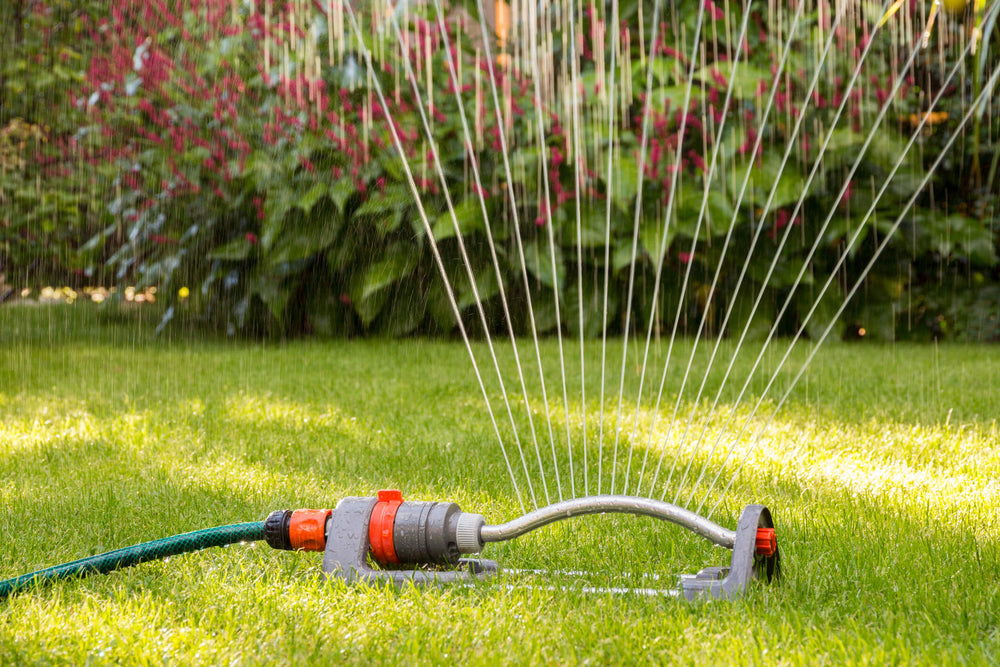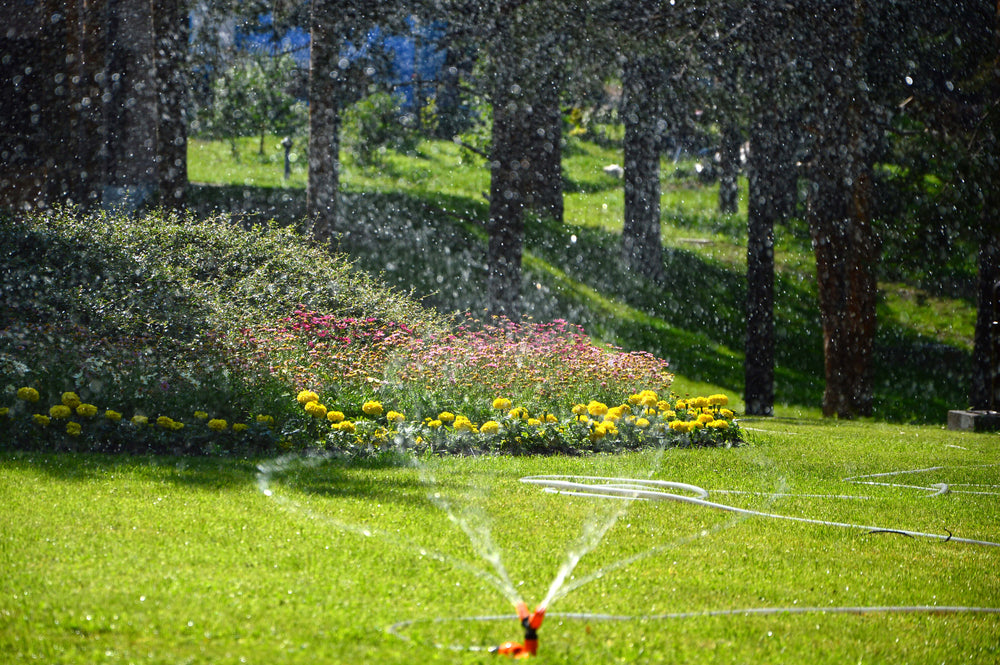
Watering your lawn may seem like a simple task, but there is no one-size-fits-all approach to maintaining lush, healthy grass in your yard. In fact, so many different opinions on lawn watering exist because many factors affect how a yard receives and absorbs water. Location, climate, grass type, and type of water used all affect how a lawn reacts to a routine watering schedule. In this article, you can learn answers to common questions about how to best water your lawn for optimal growth.
When is the best time to water your lawn?For optimal water retention and drying, an established lawn should be watered between 5 and 10 AM. On temperate days, you can water your lawn any time before 4 PM, but it is still safer to water earlier in the day. Watering your lawn in the heat of the day causes as much as 30% of the water to evaporate before it can penetrate your lawn. On the other hand, watering your lawn too late at night causes it to retain for too long, raising the risk of lawn disease.
What is the best way to water a lawn?Lawns are typically watered in one of three ways: by hand, with an above-ground sprinkler, or with a home irrigation system installed by a professional.
Hand watering
Hand watering your lawn with a hose and sprayer nozzle is by far the most tedious method, but it also allows you to get tangible feedback on how well you are watering. Hand watering allows you to keep a close eye on your lawn’s root system and the moisture levels present in the soil. It also prevents you from wasting water and ensures you get proper coverage on all parts of your grass.
Pros of hand watering
- Helps keep a close eye on lawn
- Wastes less water
- Allows for consistent coverage
Cons of hand watering
- Time consuming
- Inefficient
Above-ground sprinklers
Above-ground sprinklers connect to a hose and can be placed at any part of your yard that the hose can reach. If your yard is large, you may need to relocate the sprinkler to fully cover your entire lawn. Above-ground sprinklers are common because they are more convenient than hand watering and are much less expensive than home irrigation systems.

Pros of above-ground sprinklers
- Convenient
- Inexpensive
Cons of above-ground sprinklers
- Must be watched closely
- May need to be moved to accommodate entire lawn
Home irrigation systems
Home irrigation systems are networks of underground sprinklers that are often set to a predetermined schedule to water a lawn. These systems allow for precise monitoring of how much your lawn is watered and, if installed correctly, provide much more consistent coverage than hand watering or above-ground sprinklers. Irrigation systems can also be used with a feeder system that can mix pest control formula, rust preventers, fertilizers, or any other treatment into water as it sprays onto a lawn. While they are incredibly convenient, home irrigation systems are expensive to install and can be a headache to maintain.
Learn more: How to remove rust stains from concrete
Pros of home irrigation systems
- Convenient
- Allow for feeder systems
- Save time
- Efficient
Cons of home irrigation systems
- Expensive
- Complicated maintenance
Established lawns only need to be watered once or twice per week for 25 to 35 minutes each session. Most grass types require about 1 to 1.5 inches of water each week for optimal growth. An average home sprinkler produces about an inch of water each hour it runs, so running a sprinkler for 30 minutes twice a week should be suitable for most lawns with no rainfall. Deep, infrequent waterings are key to maintaining the health of your lawn. This stresses the importance of following an appropriate watering schedule. For example, watering your lawn for 20 minutes three times per week is not as effective as 30-minute waterings twice per week. Longer waterings penetrate deeper into the ground and allow the roots to reach water lower in the soil. Roots that are further from the surface are less likely to suffer damage from excessive heat or pests. Note that this only applies to established lawns. Newly seeded lawns require special care and different watering frequencies. Continue reading below for instructions for newly seeded lawns.
Pay attention to soil type
The type of soil is another factor in determining how much water to give your lawn. Clay-heavy soil, for example, retains water much better than sandy soil. As a result, clay soil requires less water than sandy soil. However, clay soil can retain water too well, forcing the roots to sit in water for too long and raising the potential for disease. Loamy soil, a mixture of clay, sand, and silt, possesses the ideal characteristics for overall lawn health.
Watch out for rainfall
When following a lawn watering schedule, pay close attention to the weather forecast for the week. Never water your lawn right before or after a rainfall, as this can cause the roots to sit in water for too long, raising the risk of fungal disease. If you use an automatic irrigation system to water your lawn, ensure to adjust the system’s schedule if rainfall saturates your lawn. Including rainfall and manual watering, your lawn should receive its usual 1 to 1.5 inches of water per week.
Water the lawn evenly
Pooling water presents a problem for lawns because it forces the soil to retain water for longer than is healthy. Make sure that whatever watering system or technique you use evenly distributes the water to your lawn. Irrigation systems installed by a professional are the most effective way to ensure equal distribution, but they are also the most expensive. If you are using an above-ground sprinkler, find a location and rotation that works for your lawn and do your best to maintain consistent placement each time you water.

The water process for a newly seeded lawn can be separated into 4 stages: newly seeded, seedling, 1-inch, and established stage. Keep in mind that the instructions below do not adjust for rainfall. Avoid watering your lawn shortly before or after each rainfall.
Newly seeded stage
Newly seeded lawns should be watered 2 to 3 times per day for 10 to 15 minutes each session. The goal for newly seeded lawns is to always keep the top inch of soil moist. The amount of watering time it takes to achieve this varies based on temperature, watering method, and soil type. To germinate, the seeds must retain the correct amount of moisture at all times. If a seed dries out, it dies, so careful attention to detail is critical while watering a newly seeded lawn. The germination process can take anywhere from 5 days to 1 month or longer depending on the weather and type of seeds. The top inch of soil must be kept moist until all seeds have germinated.
Seedling stage
Once the seeds have sprouted, you should allow the soil to dry before the next watering. You can also water the seedlings slightly longer than before, but allow more time between waterings to avoid diseases caused by constant moister to the seedlings. During the seedling stage, you can water your lawn twice a day for 20 to 30 minutes depending on weather and sun exposure.
1-inch stage
When your seedlings have started substantially growing, you can water your lawn deeper and less often. At this stage, you can continue to water the lawn for 20 to 30 minutes, but cut back the frequency to every other day. Continue this schedule until the grass reaches cutting length.
Established stage
Once the grass grows to about 3 or 4 inches, it is in its established stage. At this stage, you should water your lawn before 10 AM for 30 minutes about twice each week. Over the course of a week, your lawn should take in about 1 to 1.5 inches of water regardless of source. When your grass is established, water deeply and less frequently. Watering your lawn 3 times per week for 20 minutes each session, for example, is not as effective as watering twice each week for 30 minutes per session.
Can you water a lawn with tap water?While unfiltered tap water is considered safe to consume for humans, it can kill off good bacteria in soil. Water treatment plants add chlorine and chloramines to tap water to kill bacteria that can cause waterborne illnesses. While chlorine and chloramines are effective at killing bad bacteria, they are also good at eliminating good bacteria. As a result, it is best to use chlorine-free water on your lawn. Chlorine can be eliminated by a whole-house carbon filter, or you can collect rainwater in a rain barrel to use for watering your lawn.
Learn more: Activated carbon filters 101 | 8 best uses for harvested rainwater
Symptoms of an overwatered lawnOverwatering is possibly the most common lawncare mistake homeowners make. Unfortunately, it is also one of the most detrimental. An overwatered lawn exhibits some or all of the following symptoms:
- Spongy soil. Properly watered soil should be soft but not mushy or spongy. You can test the texture of your soil with a thin stick or screwdriver. If the stick easily penetrates the soil and the soil is not mushy, your lawn is watered the correct amount.
- Discolored grass. If grass exhibits any color other than a lush green, it may be receiving too much water. Grass that is pale is a tell-tale sign of overwatering.
- Excessive bug presence. Overly watered lawns attract pests to your yard. If you notice an excessive amount of insects and bugs, your lawn may be overwatered.
- Circular patches. While a circular patch may look like dryness, it is likely caused by a disease. Dryness in a lawn is typically equally distributed, while diseases can infect small patches of a lawn in a circular pattern.
- Mushroom growth. You may notice mushroom growth in your lawn after excessive rainfall, but they can also grow when your lawn receives too much water from your home’s sprinkler or irrigation system.
- Excessive weed growth. Weeds thrive when soil is constantly moisturized. Weeds also have shorter roots than grass, so constant moisture at the top of soil ensures optimal conditions for weeds to grow.

While underwatering is less common than overwatering, it can still occur if you forget to water or if an irrigation system’s timing mechanism fails. An underwatered lawn can exhibit any of the following symptoms:
- Dryness. Dry soil is the most tell-tale sign of underwatering. To test for dry soil, use a screwdriver or a thin stick to puncture the ground. If the stick does not push through and is not impeded by a rock or other obstruction, the soil is too dry.
- Impaired growth. Grass that does not receive enough water grows slowly. Over time, this may cause the size of the grass blades to change.
- Yellow patches. Yellow patches are often caused by user error when placing a sprinkler system. If the rest of your lawn is lush but you notice a few yellow patches, your sprinkler coverage may be lacking.
- Visible footprints. If you walk across an underwatered lawn, you may notice footprints last longer than they should. This is caused by a lack of water in the blades leading to low springback.




